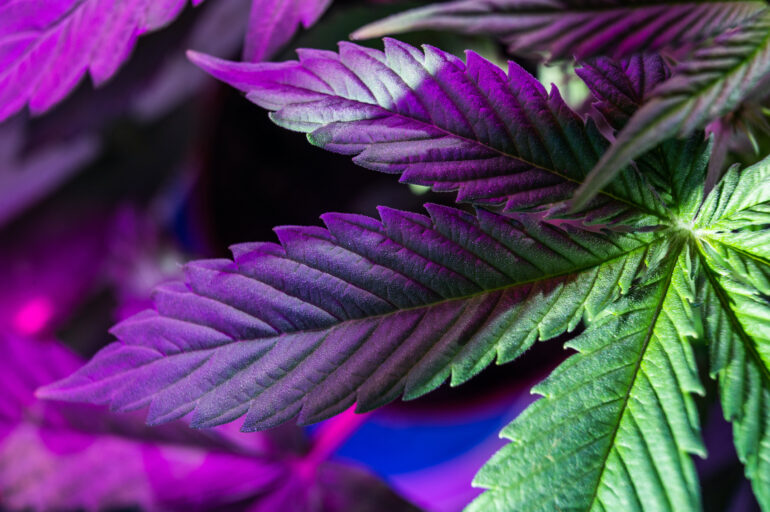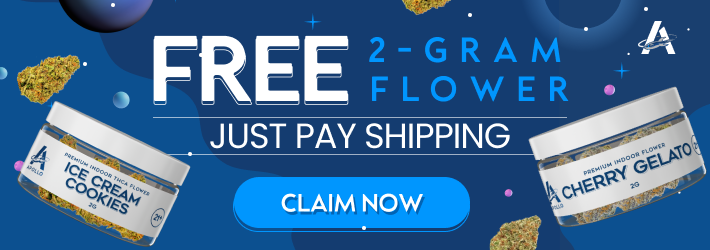The cannabis industry is always evolving, and the cannabinoids below show this statement as fact. Over the past two to three years, there have been some extraordinary cannabinoid discoveries, namely THCP and CBDP in 2019. But, it’s important to remember cannabinoid discovery didn’t end here. Cannabis producers and researchers uncovered many brand new and exciting ones between 2019 and now. And they’re all there waiting for you to experience.
The Hottest Cannabinoids You Should Look Out for in 2023
HHC-A
HHC-A (hexahydrocannabonolic acid) is a semi-synthetic cannabinoid and a hydrogenated form of THCA (tetrahydrocannabinolic acid). Hydrogenating THCA and converting it into HHCA is a complex process. Producers take isolated THCA, treat it with hydrogen, and expose it to a catalyst such as nickel or platinum. Hydrogenation improves compound stability and thermo-oxidative breakdown resistance.
Studies on HHCA’s effects in mice are promising. HHCA reduced tumor size in mice test subjects by 39.70% compared to THCA, which reduced tumor size by 37.67%.
HHC-O
HHC-O is a very new cannabinoid and one you’ve likely never heard of before. It’s a semi-synthetic cannabis compound and an acetylated form of HHC, which is a hydrogenated version of THC. Producers make HHC-O by combining naturally sourced HHC with acetic anhydride and a nickel or platinum catalyst. Acetic anhydride is a chemical compound that facilitates greater CB1 binding affinity, thus leading to an equally greater euphoric high.
Some producers claim HHC-O is 1.5 to three times stronger than HHC. However, HHC-O users believe it’s far more potent, especially when vaporized. Some Reddit users recommend mixing HHC-O with CBD to counteract the high and induce more relaxation.
HHC-P
HHC-P is short for hexahydrocannabiphorol, an intoxicating semi-synthetic cannabinoid and a hydrogenated form of THCP. It’s incredibly stable and highly resistant to heat and UV light, boasting a long shelf life and little deterioration over long periods.
Marketers boldly declare that HHCP products are up to 30-times more potent than delta-9, boasting higher bioavailability and a longer-lasting euphoric high, which is purely anecdotal and not backed by conclusive studies. One article even states it’s 100 to 200-times more potent. Highly doubtful. Users claim HHCP is the strongest cannabinoid currently on the market, outshining THCP and THC-O.
CBN-O
CBN-O, also known as CBN-O acetate, is a rare minor cannabinoid belonging to the cannabinol (CBN) cannabinoid family. Like CBN, CBN-O interacts with your endocannabinoid system, specifically your cannabinoid receptors.
Users claim CBN-O is stronger than CBN, typically experiencing euphoric, sedative, and stress-relieving effects. One Reddit user believes CBN-O combats migraines and reduces nausea and anxiety with few after-effects the next morning. Another Redditor explains how CBN-O dosing is a “lifesaver” for THC withdrawal, possibly resulting from CBN and CBN-O’s ability to interact with CB1 receptors. Most CBN-O products are in distillate or isolate form. Distillates are thick, gooey substances like honey, while isolates are crystal-like substances similar to powdered sugar. Both are potent and potentially great for moderate pain and stress symptoms.
THCP-O
THCP-O is short for tetrahydrocannabiphorol acetate. It’s a semi-synthetic cannabinoid and the acetated form of THCP. Thanks to its seven-link carbon chain and “-O” functional group, THCPO is powerfully intoxicating and psychoactive, and users can experience a euphoric high that’s considerably more potent than delta-8 and delta-9. A YouTuber recently vaporized 5% THCP-O with 34% HHC, 28% delta-8, 24% CBG, and 9% CBD and experienced a euphoric high for almost ten hours. Therefore, THCP and THCPO are not suitable for beginners. However, THCPO products might be good for pain relief and sleep support in more experienced cannabis users.
Find THCP-O products at Vivimu
THCb
THCb (tetrahydocannabutol, Δ9-Tetrahydrocannabutol, tetrahydrocannabinol-C4) is an intoxicating minor cannabinoid and a homologue of delta-9 THC naturally present in cannabis. The main difference between the two is that THCb has a butyl side chain, while THC has a pentyl side chain. THCb has a better binding affinity at CB1 receptors than THC, but almost equal affinity at CB2 receptors.
Unverified reports claim THCb is 13-times stronger than delta-9 and over 20-times more potent than delta-8. Research suggests THCb is a possible pain reliever and anti-inflammatory.
THCjd
THCjd (tetrahydrocannabioctyl) is a rare octyl cannabinoid and THC isomer naturally present in cannabis. An octyl cannabinoid means it has an alkyl side chain composed of eight carbon atoms, leading many to believe it’s roughly 19-times more potent than delta-9, which is scientifically unverified but most likely true. Research shows that a cannabinoid requires a side chain of at least three carbon atoms to bind to CB1 receptors; the optimal number is five. Anything higher and it becomes better at CB1 binding (generally), thus leading to a more intense and noticeable high not suitable for beginners.
Users claim mild THCjd doses can promote relaxation and pain relief, but there’s a risk of heightened anxiety and paranoia in higher doses.
Find THCjd products at Delta Extrax
THC-H
THC-H, short for tetrahydrocannabihexol and more formally known as Δ9-THCH, is a naturally-occurring cannabinoid and hexyl homolog of delta-9 THC. It was officially discovered in the cannabis plant at the same time as THCP, CBDP, and CBDH in 2019. However, scientists invented a synthetic THCH equivalent called parahexyl back in 1949, which was used by doctors as an anti-anxiety treatment in the mid-20th century. Parahexyl is an illegal substance under the US Controlled Substances Act, but naturally-occurring THCh is likely legal under the Agricultural Improvement Act (2018 Farm Bill).
How Many Cannabinoids Have Been Discovered So Far?

There are roughly 545 different chemical compounds identified in cannabis, of which over 104 are phytocannabinoids. “Phytocannabinoid” means any cannabinoid present within any variety of cannabis, including hemp and marijuana. The two most abundant cannabinoids are cannabidiol (CBD) and delta-9 (THC). Other common cannabinoids include cannabigerol (CBG) and cannabichromene (CBC). THCP, CBDP, CBDH, and THCH are the latest additions to the cannabinoid family, along with THCb and CBDb.
Non-cannabinoid compounds such as terpenes (limonene, pinene, caryophyllene) and flavonoids (cannflavins A, B, C) also exist.
Terpenes are a group of volatile unsaturated hydrocarbons found in cannabis essential oils. Roughly 400 terpenes are in cannabis, each responsible for a cannabis plant’s unique and distinct aromatic qualities. The most common terpenes are myrcene, pinene, and limonene. Research shows myrcene is a possible muscle relaxant, pinene an anti-inflammatory, and limonene an anxiolytic.
Flavonoids are groups of polyphenolic compounds that give cannabis plants their pigmentation. There are over 20 flavonoids in cannabis, including flavone and flavonol aglycones and glycosides. The flavones cannflavin A, B and C are the most well-known, and many believe they’re compounds only present in cannabis. However, this belief isn’t quite true. Cannflavin A has been identified in Mimulus bigelovi (Bigelow’s Money Flower), a plant belonging to the Phrymaceae family.
What Is the Strongest Cannabinoid?
The winner of the strongest cannabinoid award goes to THCP (tetrahydrocannabiphorol). It’s over 30-times more active (1.2 nM) at cannabinoid 1 receptors than delta-9 (40.1 nM)*, and causes an intense and heavily intoxicating euphoric high, even in moderate doses. The reason for THCP’s superior binding affinity is it has a seven-link alkyl side chain, whereas delta-9 and delta-8 have five-link side chains. Research shows binding affinity with CB receptors requires an alkyl side chain of at least three carbon atoms. The optimal length is five carbon atoms.
However, contrary to common belief, THCP isn’t over 30-times stronger than delta-9. Users claim THCP products are roughly five to ten times more potent.
*The lower the nM value, the better a cannabinoid is at binding to cannabinoid receptors.
Does CBD Still Have a Future?
Yes. Despite all these new, up-and-coming rare cannabinoids currently hitting the shelves, CBD does have and will likely always have a bright future. It’s arguably the most popular cannabinoid, rivaled only by delta-9 and delta-8.
According to Brightfield Group, CBD sales reached $5.3 billion in 2021, a 15% increase from 2020. CBD drinks and gummies saw the largest year-on-year growth at 71% and 44%, respectively. CBD sales could reach the $16 billion mark by 2026.
However, users worldwide often consume CBD with other cannabinoids, either as part of a full-spectrum hemp product or mixed separately with specific cannabinoids such as CBG or delta-8. CBD is typically the central cannabinoid in all these products because of its various health benefits, including neuroprotection, sleep promotion, and anti-stress and anxiety.
Conclusion
Excited about these cannabinoids? Good. Because we are too. It’s incredible to witness the cannabis industry constantly evolving, innovating, and bringing you products to be excited about. However, it’s important to remember that these cannabinoids to look out for in 2023 are in their infancy. Always practice due diligence and purchase products from a reputable company that prioritizes your safety above all else, which means producing Certificates of Analysis (COAs) at the very least.

